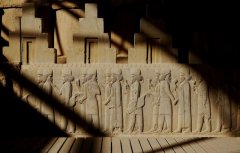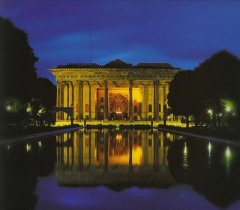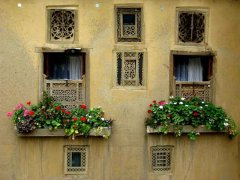HOLIDAY IN IRAN - CULTURE - Persian romance...
The Romance with Persia
West of Iran has been the birth place of most beautiful love stories such as Shirin and Farhad. Great historical works of arts including national traditional music, group dancing, delicious food and pastry are among things you will enjoy out there.
Romance of Persia can be the novel of your life as you will visit beautiful cities such as Tehran, Shiraz, Zeinoddin, Yazd, Isfahan, Hamedan, Kermanshah, Sanandaj and Oramanat. This tour will bring you an unforgettable trip full of valuable memories for whole of your life. We suggest this tour for spring, summer and at the beginning of autumn, due to the cold and snowy weather of west and northwest of Iran.

Day 1: arriving in Tehran and visiting Tehran
Upon your pre-dawn arrival in Tehran airport, you will be cordially received by our representative carrying our logo show card (transfer information) that will direct and transfer you to your hotel. You will have time to rest and relax before our morning tour of Tehran commences. Tehran, a modern megalopolis, prides itself in having unique museums with immense and unrivaled collections and artifacts dating from the earliest onset of history to the present era.
Our tour begins with a trip to the Archeological Museum, one of the rare places in the world where we will have the special opportunity to visit and experience the “evolution of mankind” through the marvelous display of historical relics.
Next on the agenda is our very much-awaited chance to savor the distinctive flavor of Iranian cuisine. Lunch will be set in an exquisite traditional Iranian restaurant where we will sample a wide range of delightful Persian dishes and desserts.
Afterwards, we will visit a world of jewels in a priceless Crown Jewels Museum one of which is one of the two greatest diamonds, Darya-e-Noor (the sea of light).
At the end of the day, we will get a chance to see a variety of Persian hand-woven carpets and rugs in the Carpet Museum which houses more than 100 spectacular pieces from all over Iran. On top of that, we will also be given an insight into the history of these carpets. Stay overnight in Tehran.
Attention: The priority in sightseeing may be changed due to the time of your arrival, preference of your guide and also official and unofficial holidays of some museums.
Day 2: visiting Tehran, fly to Shiraz
A morning visit to Sa'ad Abad Complex with an immense area of 1,100,000 square meters and 18 magnificent historical palaces (2 of which we will visit). This palace was built by Pahlavi dynasty and it will undoubtedly leave a lasting impression on us. And our Tehran excursion will end at the Ceramic Museum where we will be able to witness its construction with glorious ancient archaeology. Then we leave the hotel for a tasty Iranian lunch in a traditional restaurant. Afterwards we will transfer to the airport for the flight to Shiraz. On the way to transfer to hotel we will pay a visit to Shah e Cheragh. This is one of the most beautiful shrines in Iran which its beautiful dome, wonderful lighting and Mirror-work impressed you. Stay overnight in Shiraz.
Day 3: visiting Shiraz
Shiraz has a reputation as an enlightened city that has been at the centre of Persian culture for more than 2,000 years, and was at one time the country's capital.
Shiraz is crowned as the heartland of Persian culture and this city of sophistication will never fail to conjure up images of roses and nightingales, gardens and poetry. Early in the morning, relish in the highlights of Shiraz when it was the capital of Iran during the Zand Dynasty. Be inspired by the glorious Karim Khan palace, the splendid Vakil mosque, Vakil Bazaar and Saray-e-moshir with its splendid architecture and interesting ethnic souvenir shops, Nasir Almolk mosque. Next, we will stop for a mouth-watering Iranian lunch at one of the traditional restaurants of Shiraz.
This gorgeous city in the province of Fars is home to famous poets such as Hafez and Sa'adi and historical sites from different eras stretching back 6,000 years ago can be found. Hafez is one ofthe great poets who impressed everyone with his mastery. His poems give us a special feeling and the peace in his tomb is really outstanding. Sa’adi is a poet, philosopher and mystic who is known as the father of alternative tourism. About seven previous centuries he travelled to different countries and cities. Then he collected all his experiences in verse and Rhyme prose in two books named Boustan and Golestan. These two books give you Lots of inspiration and information. We will get a chance to pay homage to tombs of these great poets.
In the evening, we will visit Ali-Ebn-e-Hamzeh and be prepared to marvel at its beauties. Take a stroll through the Jahan Nama Garden and witness its tall and proud cedars. Finally visit the Delgosha Garden and Khajoy-e-Kermani tomb from where the perspective of the mysterious city of Shiraz will perpetuate in our mind.
At night, we will have dinner in a restaurant with specific atmosphere in the north of Shiraz.
Day 4: an excursion to Persepolis and Necropolis
Our excursion for today is Persepolis. Founded by Darius I in 518 B.C., Persepolis was the capital of the Achaemenid Empire. It was built on an immense half-artificial, half-natural terrace, where the king of kings created an impressive palace complex inspired by Mesopotamian models. The importance and quality of the monumental ruins make it a unique archaeological site. It seems that Darius planned this impressive complex of palaces not only as the seat of government but also, and primarily, as a show place and a spectacular centre for the receptions and festivals of the Achaemenid kings and their empire such as Nowruz.
The next is Necropolis. Opposite of the mountain of Mercy, ten-minute drive to the north, proudly stands the Necropolis, the magnificent burial place of Achaemenid kings. The site also provides seven bas-reliefs dating back to Elamite and Sassanid period.
ercy, ten minutes driving to the north, proudly stands the Necropolis, the magnificent burial place of Achaemenid kings. The site also provides seven bas-reliefs dating back to Elamite and Sassanid period.
Day 5: Drive 484 km to Zeinoddin, via Pasargadae & Abar Kouh
On the way we will have a few short stops in Pasargadae to visit the most important and majestic monuments there. The tomb of Cyrus the Great, the originator and the great founder of Achaemanian Emperor, (500 years BC) is the oldest historical tomb. The wonderful architecture of his tomb, the huge fertile land over there beside the brave personality of Cyrus the Great impressed the visitors. This Archeological environment was the worshiping place for the followers of several religions and still it is so. Followed by the relief of the winged man and get familiar with its historical elucidations some researchers gave specific theories regarding the relation between personality of Cyrus the Great and one of the prophets of Holy Book. By visiting this majestic tomb you can have your personal comment about it. Abar Kouh, a historical city, is the place to historical sites and wonderful desert architecture. Old trees in any region are the symbol of archaism and evidence that appropriate weather and nice condition lead to long life. The 4500 year old cypress tree in Abar Kouh is a marvelous attraction out there. These beliefs and the beauty of the 4500 year old cypress tree leave a trace of eternity in the heart and on the mind of all travelers.
Afterward we will visit Zeinoddin, a Safavid Caravanserai in the heart of desert which is restored in the best way possible and got 2 awards from UNESCO in 2005 and 2006.
Day 6: driving to Yazd, visiting Yazd and Sar Yazd
Mehriz is located 30 kilometers south of the city of Yazd. Mehriz consists of one central district and five village centers. According to historians, the name belongs to "Mehrnegar" the beloved daughter of Anoushirvan, the Sassanid King. Mehriz was known, during the late Sassanid era (4th century AD), as a natural pleasant area. One of the most important places to visit in Mehriz is Saryazd.
Sar Yazd has a castle belonging to Sassanid era which is used as a haven in time of war. Another historical place out there is caravanserai in Saryazd which dates back to Seljuk and Safavid era. It is noteworthy that Saryaz has one of the best pomegranates of Iran. After that we will be transferred to Yazd.
Yazd, the oldest adobe city in the world which is surrounded by the 4000m summit of Shirkooh and two majestic deserts of Iran, Dasht-e-Kavir and Kavir-e-Loot. This ancient city is furnished with mosques of stunning beauty. The co-existence of the splendid fire temples and the holy sites of different religions astonish every visitor.
Day 7: in the morning visiting Yazd, in the evening driving to Isfahan
Today’s tour includes visiting Dakhmeh (tower of silence, where Zoroastrians leave the dead corpse to be eaten by vultures). The Zoroastrian fire temples are the next steps which come under three categories in terms of importance: Dadgah fire that is lit at residence and has no consecration ceremony. It is lit by the Zoroastrian priests, but ordinary people could light it too. We will get a breath-taking perspective of the oldest adobe city.
Our morning tour we will also include visiting the marvelous Water museum, Jame' mosque and Doulat Abad Garden.
Lunch will be served at a traditional restaurant. Afterwards we will depart from the hotel and move towards Isfahan. On this day, we will drive 300 km from Yazd to Isfahan which is in the vicinity of Dasht-e-Kavir and the attractive city of Nain. Nain is known as the city of cisterns and possesses around 80 cisterns. We will get a chance to visit one of the oldest and most important mosques of Persian Islamic architecture. Stay overnight in Isfahan. If possible different bridges of thirty three bridges will be seen.
Day 8: visiting Isfahan
Isfahan, the legendary city which never fails to enchant its visitors, is the pearl of traditional Islamic archeology. This city is revived by the works of contemporary artists. Isfahan prides itself in having fascinating historical garden palaces. Legend has it that the city was founded at the time of Tahmoures or Keykavous and because of its glories has been entitled “Half the World”. Our full day tour includes the famed Imam Square (Naqsh-e-Jahan), a huge square second in the world to Beijing's Tiananmen Square. Tour the architectural marvels of Sheikh Lotfollah and Imam Mosques, Aliqapu Palace, Chehel Sutoon and Hasht Behesht Palaces, and also visit one of the most famous bazaars in Iran, where we can purchase the arts & crafts for which Isfahan is so well renowned. Stay overnight in Isfahan.
Day 9: visiting Isfahan
Isfahan’s Jame' mosque holds in itself the passage of several centuries of historical Islamic evolution. This mosque is a gallery of Islamic architecture in which the progress of the architecture from the outset of Islam till recent times is evident. Then we will visit Vank Church which is one of the most beautiful Armenian churches in the world and will undoubtedly capture the attention of every Christian. Our day will conclude with a visit to Monar Jomban, the tomb of a Sufi with its shaking minarets and some historical bridges. Evening is free at leisure.
Day 10: driving to Hamedan via Khansar & Golpaygan & Mahalat
Today we will drive to Hamedan. The Isfahan-Hamedan road is one of the most beautiful roads of Iran because it passes through Mount Zagros. On this way you will visit the marvelous attraction of Zagros besides paying a visit to Khansar which is the city of honey in Iran, Golpaygan which is the city of dairy in Iran and Mahalat which is the city of flower in Iran.
Day 11: visiting Hamedan and Ali Sadr Cave
Hamedan province is situated in the Middle Western Iran. It has long and severe winters from September to May with a great deal of snow; however, in summer its pleasant climate offers visitors a welcome break from the soaring temperatures elsewhere. The province is famous for its raisins (1500 hectares of vineyards) and in the Persian rug trade it ranks second only to Kerman.The next beautiful sightseeing in Hamedan is Esteroo Mord Khay (Ester and Mord Khay) Tomb. Located in the city center, the structure has been constructed of brick and stone. This is the tomb of Ester the Queen of Shoosh (the wife of Xerxes of Iran). Mordecai (Mord Khay) was her uncle. The structure was originally constructed about 11 centuries ago, in order to pay homage to these two personalities. This vicinity is a place for pilgrimage of the Jewish sect, and is also held in respect by the Moslems.
The next place is Ganj Nameh Inscription. These inscriptions are relics from the period of 'Darius' and ‘Xerxes' of the Achaemenian era. The said are located 5 km. west of Hamadan at the end of the Abbas Abad Valley, and have been engraved on a mountain.As Avicenna were Muslim Persian physician and philosopher, and wrote almost 450 treatises on a wide range of subjects, of which around 240 have survived. In particular, 150 of his surviving treatises concentrate on philosophy and 40 of them concentrate on medicine, our next step will be Avicenna Tomb.Hegmatane Archeological Palace is located in the city of Hamadan, dating to the 6th century BC. The said structure is from the times of the 'Medes'. 'Kiyakesar Madi' and 'Nabopolasar Baboli' were responsible for building this structure in the year 614 BC.
The next fascinating step will be Gonbad-e Alavian (or Masjid-e Alavian) which is a four-sided interesting 12th century mausoleum belonging to the late Seljuk period. On the exterior, it resembles the Gonbad-e Sorkh of Maragheh. (If it will be possible we will see the sight.) Our next site to visit is the tomb of Baba Taher, which is located in a park, surrounded by flowers and winding paths. Baba Taher is known as one of the most revered and respectable early poets in Iranian literature. He was known by the name of Baba Taher-e Oryan (The Naked), which suggests that he may have been a wandering dervish. His poetry has touched many souls. The last stop will be at Ali Sadr Cave which is the world's largest water cave which attracts millions of visitors every year. It is located about 100 kilometers north of Hamedan, western Iran. Since the cave is situated between the large cities Hamadan, Tehran, and Qom it is a popular destination for Iranians. Tours of the cave are available by pedal boats.
Day 12: Excursion to Kermanshah
Drive 200 km. westward to Kermanshah from Hamedan. Kermanshah has a moderate and mountainous climate. In an old town called Kangavar we will visit the Anahita Temple-the mother goddess of abundance and guardian of water in ancient Persia. Carry on the old caravan route to Bistoon dating back to the Middle Paleolithic. The Achaemenian inscriptions offer details in 1,200 lines about the battles of Darius the Great who fought against the governors trying to dismantle the Empire originally founded by Cyrus. This was the site where the decisive battle took place, leaving the famous Tablets of Darius. Nearby in the village of Sahneh we can visit the tomb of Ostad Khalil Alinejad the best player of Tanboor in the world.In Kermanshah visit the Sassanian rock carvings of Tagh-e-Bostan. These bas-reliefs, cut from the stone cliff, depict royal scenes of battles and hunts reflecting the glorious history of the Sassanid Kings. Drive back to Hamadan and stay overnight
Day 13: driving to Oranamat via visiting Sanandaj
Sanandaj is the capital of Kurdistan province. The economy of Sanandaj is based upon the production of carpets, processing hides and skins, milling rice, refining sugar, woodworking, cotton weaving, metalware and cutlery.Among sightseeings of Sanandaj you may visit Old bazaars of Sanandaj and Hajar Khatoon Mosque which is architecturally a unique and ancient Muslim mosque (now a tourist destination) in the city. Hajar Khatoon Mosque was built more than hundred years ago by Haj Sheikh Shokrollah. Afterwards we drive to reach the Oranamat Takht village. The Oramanat Takht Village is one of the attractive rural areas of Kurdestan which besides its panoramic views has valuable tourism capacities because of the annual performance of an ancient and wonderful ceremony of Peer Shahriar. The Sirvan River flows in the deep valleys of this region and enter Iraq. Here the lands are covered with walnut, pomegranate, fig and mulberry trees.Fly to Tehran. Stay overnight in Tehran.
Day 14 - depart Iran
Depart Iran the land of warmth and hospitality with fond memories.
URLAUB IN IRAN - KULTUR - Persische Romanze
romance-1.jpg
romance-2.jpg
romance-3.jpg
romance-4.jpg
romance-5.jpg
romance-6.jpg
romance-7.jpg


 English
English  Deutsch
Deutsch  简体中文(中国)
简体中文(中国)  French
French  Persian
Persian 






